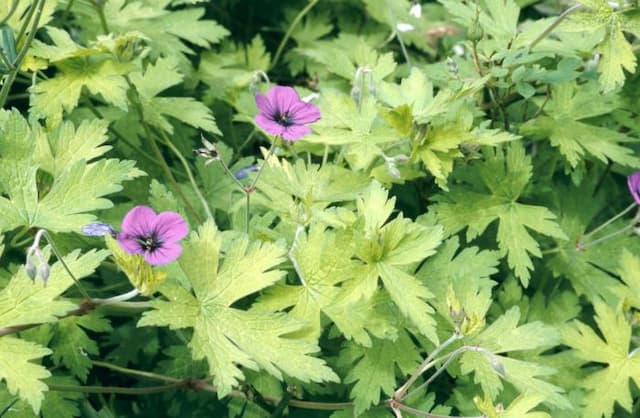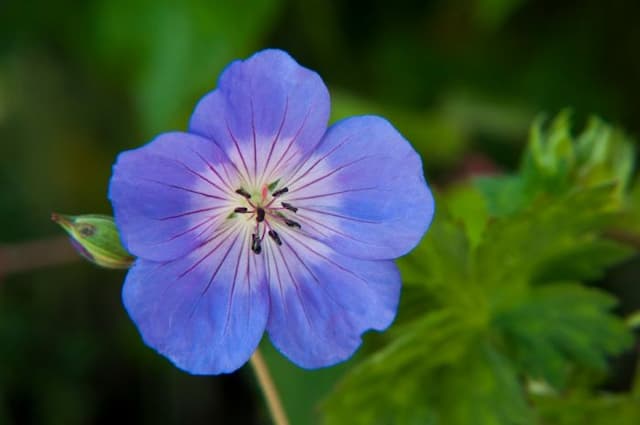Scented geranium Pelargonium 'Lotusland' (Dw/st/c)

ABOUT
Pelargonium 'Lotusland' is commonly known as a geranium, which has a distinctive appearance. It features rich, velvety green foliage that creates a plush background for its flowers. The leaves are typically rounded with a soft, scalloped edge, emanating a lush and textured look. This geranium variety showcases blooms that stand out brilliantly against the leaves; these flowers are often vibrant and colorful, coming in shades that could range from bright pinks to deep reds, sometimes accented with striking patterns or darker markings on the petals. The geranium's blooms form in clusters atop sturdy stems, each cluster consisting of several individual flowers that together create a showy display. Additionally, the blossoms can exhibit a variety of forms, from the more traditional geranium look to fancy doubles that resemble tiny roses. Some may also have a delightful fragrance that adds to the sensory appeal of the plant. The overall appearance of Pelargonium 'Lotusland' is one of cheerful exuberance, commonly favored for adding a pop of color and charm to gardens, pots, or hanging baskets.
About this plant
 Names
NamesFamily
Geraniaceae.
Synonyms
Lotusland Geranium, Lotusland Pelargonium.
Common names
Pelargonium 'Lotusland' (Dw/st/c)
 Toxicity
ToxicityTo humans
Geraniums, including the Pelargonium 'Lotusland', are generally considered non-toxic to humans. However, ingestion of large quantities may cause minor symptoms such as stomach upset, vomiting, or diarrhea. It's always advisable to keep plants out of the reach of small children who might chew on them out of curiosity.
To pets
Geraniums, including the Pelargonium 'Lotusland', can be toxic to pets, particularly to cats and dogs. If ingested, they may cause symptoms like vomiting, diarrhea, depression, anorexia, and dermatitis. In rarer cases, ingestion could lead to more severe reactions such as hypotension. If you suspect your pet has ingested part of a geranium plant, it is best to consult a veterinarian.
 Characteristics
CharacteristicsLife cycle
Perennials
Foliage type
Evergreen
Color of leaves
Green
Flower color
Pink
Height
1-2 feet (30-60 cm)
Spread
1-2 feet (30-60 cm)
Plant type
Shrub
Hardiness zones
10
Native area
South Africa
Benefits
 General Benefits
General Benefits- Ornamental Value: Pelargonium 'Lotusland' adds aesthetic appeal to gardens with its vibrant flowers and decorative foliage.
- Low Maintenance: This pelargonium variety is known for being easy to care for, requiring minimal upkeep once established.
- Drought Tolerance: Lotusland can withstand periods of low water, making it suitable for xeriscaping and water-efficient gardens.
- Pest Resistance: The plant is relatively resistant to common garden pests, reducing the need for chemical treatments.
- Versatility: It can be used in various garden settings, including borders, containers, and as a bedding plant.
- Long Blooming Period: The Lotusland variety often has a prolonged flowering season, providing color for an extended time.
- Attracts Wildlife: The flowers can attract pollinators such as bees and butterflies, enhancing biodiversity in the garden.
- Climate Adaptability: It's adaptable to a range of climates, making it suitable for many gardeners in various regions.
- Easy Propagation: The plant can be easily propagated from cuttings, allowing gardeners to expand their collection or share with others.
 Medical Properties
Medical PropertiesThis plant is not used for medical purposes.
 Air-purifying Qualities
Air-purifying QualitiesThis plant is not specifically known for air purifying qualities.
 Other Uses
Other Uses- Pelargonium 'Lotusland' can be used to create natural dyes for fabrics, with different parts of the plant producing varied hues.
- The slightly scented leaves may be infused to create aromatic oils for use in aroma diffusers, providing a subtle fragrance to a room.
- The plant can be incorporated into potpourris; dried leaves add texture and a mild scent to the mixture.
- Its dried flowers can be used to decorate candles; when embedded in the wax, they provide a decorative element as well as a faint natural aroma when the candle burns.
- Geraniums can serve as companion plants in the vegetable garden, as they are believed to repel certain types of insects and pests.
- The leaves can be placed in cupboards or drawers as a natural insect repellent to protect clothes and linens from moths and other insects.
- Pelargonium 'Lotusland' can be crushed and used as a natural pest repellent in gardens without the use of chemicals.
- The flowers can be used as edible decorations for cakes and desserts, offering a colorful touch to the presentation of food.
- A sachet filled with dried leaves and flowers can be placed under pillows for a gentle scent, possibly aiding in better sleep with its natural aroma.
- The vibrant flowers may be used in crafting, such as in making bookmarks or pressed flower art, which can be a creative way to preserve the beauty of the plant.
Interesting Facts
 Feng Shui
Feng ShuiThe plant Geranium is not used in Feng Shui practice.
 Zodiac Sign Compitability
Zodiac Sign CompitabilityThe plant Geranium is not used in astrology practice.
 Plant Symbolism
Plant Symbolism- Resilience: The term 'Lotusland' harkens to a place of idealized beauty and luxury, often untouched by the world's troubles, and therefore Pelargonium 'Lotusland' could symbolize the resilience and beauty that persists amidst challenges.
- Protection and Safety: Pelargoniums in general have been used in folk medicine and are believed to ward off evil spirits, translating to a symbolic meaning of protection and safety.
- Healing: This particular Pelargonium's subtle beauty and association with an idyllic place can symbolize the calming and healing nature of plants, suggesting their use in creating spaces of tranquility and recovery.
- Hope and Rebirth: Similar to its namesake the lotus, 'Lotusland' might also represent hope, purity, and rebirth, as these are common meanings attached to the lotus flower within different cultures.
 Water
WaterGeraniums, including Pelargonium 'Lotusland', prefer to be watered thoroughly but infrequently, allowing the soil to dry out between waterings. Typically, you should water potted geraniums once every 7 to 10 days, though this may vary depending on climate and indoor conditions. When watering, add enough water so that it runs out of the drainage holes—this could mean using approximately 16 to 32 ounces for a medium-sized pot every time you water. The goal is to moisten the entire root zone without leaving the soil waterlogged.
 Light
LightGeraniums require bright, indirect light and can benefit from a few hours of direct sunlight each day; however, full day direct sun can be too intense. The ideal spot would be near a south or west-facing window where the plant can get at least 4 hours of sunlight. These plants can also thrive under fluorescent plant lights if natural light is insufficient.
 Temperature
TemperatureGeraniums thrive in temperatures between 65 to 75 degrees Fahrenheit but can survive in temperatures as low as 55 degrees Fahrenheit and as high as 80 degrees Fahrenheit. They should not be exposed to temperatures below 55 degrees for prolonged periods as this can cause damage. Ideal growth occurs within the 65 to 75 degrees Fahrenheit range.
 Pruning
PruningPruning geraniums helps to promote bushier growth and prevents legginess; it should be done in early spring. Remove dead or yellowing leaves and spent blooms, and cut back leggy stems to about 4 to 6 inches to encourage new growth. Prune every few months or as needed to maintain shape and encourage fresh foliage and blooms.
 Cleaning
CleaningAs needed
 Soil
SoilGeranium 'Lotusland' prefers a well-draining potting mix with equal parts peat, perlite, and loam. The soil should be slightly acidic to neutral, with an ideal pH range of 6.0 to 7.0. Amend with compost to enrich the mix.
 Repotting
RepottingGeraniums like 'Lotusland' should be repotted every one to two years to rejuvenate the soil and accommodate root growth. Spring is the best time for repotting these plants.
 Humidity & Misting
Humidity & Misting'Lotusland' geraniums thrive in moderate humidity levels, around 40-60%. Avoid overly humid conditions as they may promote fungal diseases.
 Suitable locations
Suitable locationsIndoor
Place in bright, indirect light and water when topsoil dries.
Outdoor
Plant in partial sun and protect from harsh elements.
Hardiness zone
9-11 USDA
 Life cycle
Life cycleThe life cycle of Pelargonium 'Lotusland', commonly known as Geranium 'Lotusland', begins with seed germination, where conditions of warmth and moisture trigger the development of the seed into a seedling. The seedling stage is characterized by the emergence of the plant's first leaves as it establishes a root system. Following this, the vegetative stage sees rapid growth of foliage, as the plant develops a sturdy stem and a more expansive root network to support flowering. The plant then enters the flowering stage, where it produces colorful blossoms that are attractive to pollinators, critical for sexual reproduction if it is not propagated by cuttings. After pollination, seeds are developed within the fruits (usually dehiscent capsules), which, when mature, are released into the environment to begin the next generation. Post-reproduction, if not maintained with proper care, the plant may eventually reach senescence, leading to a decline in vitality and potentially the end of its life cycle if annual or biennial, or it may survive through dormancy periods if it is a perennial.
 Propogation
PropogationPropogation time
Spring-Early Summer
Propogation: Pelargonium 'Lotusland', commonly known as a type of Geranium, is most commonly propagated through stem cuttings. This method is advantageous as it ensures that the offspring retain the same characteristics as the parent plant. The best time to take these cuttings is in late spring or early summer. To propagate, you should select a healthy stem that is about 4 to 6 inches (approximately 10 to 15 centimeters) long and cut it just below a node with a clean, sharp pair of scissors or a knife. Remove the leaves from the bottom half of the cutting to prevent rot and dip the cut end into rooting hormone to encourage root growth. The cutting should be placed in a well-draining potting mix, ensuring that at least one node is buried beneath the soil. Water the cutting well and place it in a warm, well-lit area but out of direct sunlight until it has rooted, which typically takes several weeks.









